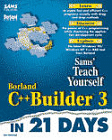by Kent Reisdorph
US/Canada:
 UK/Europe:  |
|
Teach Yourself Borland C++Builder 3 in 21 Days by Kent Reisdorph |
|
 |
Title: Author: Publisher: ISBN: Info: |
Teach Yourself Borland C++Builder 3 in 21 Days Kent Reisdorph SAMS Publishing/Borland Press 0-672-31266-2 No CD-ROM |
Usually, one starts to look at the front cover and read the back cover before opening the book itself.
In this case, it promises a lot.
According to the back cover "in no time, you will be able to rapidly build programs from reusable ActiveX controls, JavaBeans, and Delphi components".
Well, we can indeed use Delphi components to create new C++Builder programs, and we can use C++Builder to create and use ActiveX controls, but JavaBeans? I don't think so! And this is not the first time that a Delphi or C++Builder book "promises" Java or JavaBeans on the back cover.
I wonder when publishers will learn to check their facts before they put on the hype.
If we skip the cover and look inside instead, we find that the book itself is less on hype, and more focused on good quality step-by-step teaching of Borland C++Builder version 3.
The book can be divided in some parts, not necessarily consistent with the "weeks".
After the first day, which introduces the reader to the new C++Builder 3 environment, the next few days provide a basic introduction to the C++ language.
Basic, so you may certainly skip those days if you have more than a little knowledge or experience with C++ already.
Before you know it it's day 5 and you're overviewing the Visual Component Library (VCL) components (this day actually starts with showing a bitmap using the "plain" Windows API, followed by OWL, MFC and finally the VCL approach - properties, methods and events).
The next day, we'll start using the C++Builder 3 IDE, and learn the anatomy of a C++Builder project.
Week 2 starts with more detailed explorations of the most commonly VCL components, followed by a few more days focused on the IDE (code editor, debugger, tools menu, etc.).
Towards the end of week 2 and the beginning of week 3, we'll start to see more advanced topics such as specific Windows Programming techniques, graphics programming, database programming (three good days), DLLs and component building.
The last day of week 3 covers the similarities and differences between C++Builder and it's older sister Delphi 3 - this might be the best place to start for experienced Delphi programmers.
A bonus day is about internet applications.
Unfortunately, all we do in this chapter is use the THTML component to create a simple browser, and the TNMSMTP component to add e-mail capabilities.
The author also gives an overview of the NetMasters internet controls (and although the books states that these are ActiveX controls, in fact only the THTML control is an ActiveX control, the others are native VCL components), and the other native VCL internet components, without too much detail, however.
This book is an excellent place to start working with C++Builder 3, whether or not you're already familiar with Delphi or the C++ language. Each day ends with a helpful workshop, some Q/A, quiz en exercises so you can easily test yourself.
(Bob Swart)
|
|

| More Book Reviews |

|
|